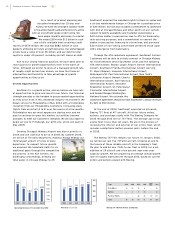Southwest Airlines 2004 Annual Report Download - page 21
Download and view the complete annual report
Please find page 21 of the 2004 Southwest Airlines annual report below. You can navigate through the pages in the report by either clicking on the pages listed below, or by using the keyword search tool below to find specific information within the annual report.cates of all other U.S. carriers. DOT may revoke such costs, the TSA has imposed an annual Security Infra-
certiÑcates, in whole or in part, for intentional failure to structure Fee, which approximated $18 million for
comply with certain provisions of the Southwest in 2003 and $26 million in 2004. This fee
U.S. Transportation Code, or any order or regulation was also suspended by Congress from June 1 through
issued thereunder or any term of such certiÑcate; pro- September 30, 2003. Like the FAA, the TSA may
vided that, with respect to revocation, the certiÑcate impose and collect Ñnes for violations of its regulations.
holder has Ñrst been advised of the alleged violation and Enhanced security measures have had, and will
fails to comply after being given a reasonable time to do continue to have, a signiÑcant impact on the airport
so. experience for passengers. While these security require-
DOT prescribes uniform disclosure standards re- ments have not impacted aircraft utilization, they have
garding terms and conditions of carriage and prescribes impacted our business. The Company has invested
that terms incorporated into the Contract of Carriage by signiÑcantly in facilities, equipment, and technology to
reference are not binding upon passengers unless notice process Customers eÇciently and restore the airport
is given in accordance with its regulations. experience. The Company has implemented its Auto-
mated Boarding Passes and RAPID CHECK-IN self
Safety. The Company and its third-party mainte- service kiosks in all airports it serves to reduce the
nance providers are subject to the jurisdiction of the number of lines in which a Customer must wait. During
Federal Aviation Administration (""FAA'') with respect 2003 and 2004, the Company also installed gate readers
to its aircraft maintenance and operations, including at all of its airports to improve the boarding reconcilia-
equipment, ground facilities, dispatch, communications, tion process. In 2004, Southwest introduced baggage
Öight training personnel, and other matters aÅecting air checkin through RAPID CHECK-IN kiosks at certain
safety. To ensure compliance with its regulations, the airport locations and also introduced Internet checkin
FAA requires airlines to obtain operating, airworthiness, and transfer boarding passes at the time of checkin.
and other certiÑcates, which are subject to suspension or
revocation for cause. The Company has obtained such Environmental. Certain airports, including
certiÑcates. The FAA, acting through its own powers or San Diego and Orange County, have established airport
through the appropriate U.S. Attorney, also has the restrictions to limit noise, including restrictions on
power to bring proceedings for the imposition and aircraft types to be used, and limits on the number of
collection of Ñnes for violation of the Federal Air hourly or daily operations or the time of such opera-
Regulations. tions. In some instances, these restrictions have caused
curtailments in service or increases in operating costs
The Company is subject to various other federal, and such restrictions could limit the ability of Southwest
state, and local laws and regulations relating to occupa- to expand its operations at the aÅected airports. Local
tional safety and health, including Occupational Safety authorities at other airports may consider adopting
and Health Administration (OSHA) and Food and similar noise regulations, but such regulations are sub-
Drug Administration (FDA) regulations. ject to the provisions of the Airport Noise and Capacity
Security. The Aviation and Transportation Se- Act of 1990 and regulations promulgated thereunder.
curity Act (""Security Act'') generally provides for Operations at John Wayne Airport, Orange
enhanced aviation security measures. The Security Act County, California, are governed by the Airport's
established a new Transportation Security Administra- Phase 2 Commercial Airline Access Plan and Regula-
tion (""TSA''), which is part of the Department of tion (the ""Plan''). Pursuant to the Plan, each airline is
Homeland Security. The TSA assumed the aviation allocated total annual seat capacity to be operated at the
security functions previously residing in the FAA and airport, subject to renewal/reallocation on an annual
assumed passenger screening contracts at U.S. airports basis. Service at this airport may be adjusted annually to
in February 2002. The TSA provides for the screening meet these requirements.
of all passengers and property, which is performed by
federal employees. Beginning February 1, 2002, a The Company is subject to various other federal,
$2.50 per enplanement security fee is imposed on state, and local laws and regulations relating to the
passengers (maximum of $5.00 per one-way trip). This protection of the environment, including the discharge
fee was suspended by Congress from June 1 through or disposal of materials such as chemicals, hazardous
September 30, 2003. Pursuant to authority granted to waste, and aircraft deicing Öuid. Regulatory develop-
the TSA to impose additional fees on air carriers if ments pertaining to such things as control of engine
necessary to cover additional federal aviation security exhaust emissions from ground support equipment and
3
























